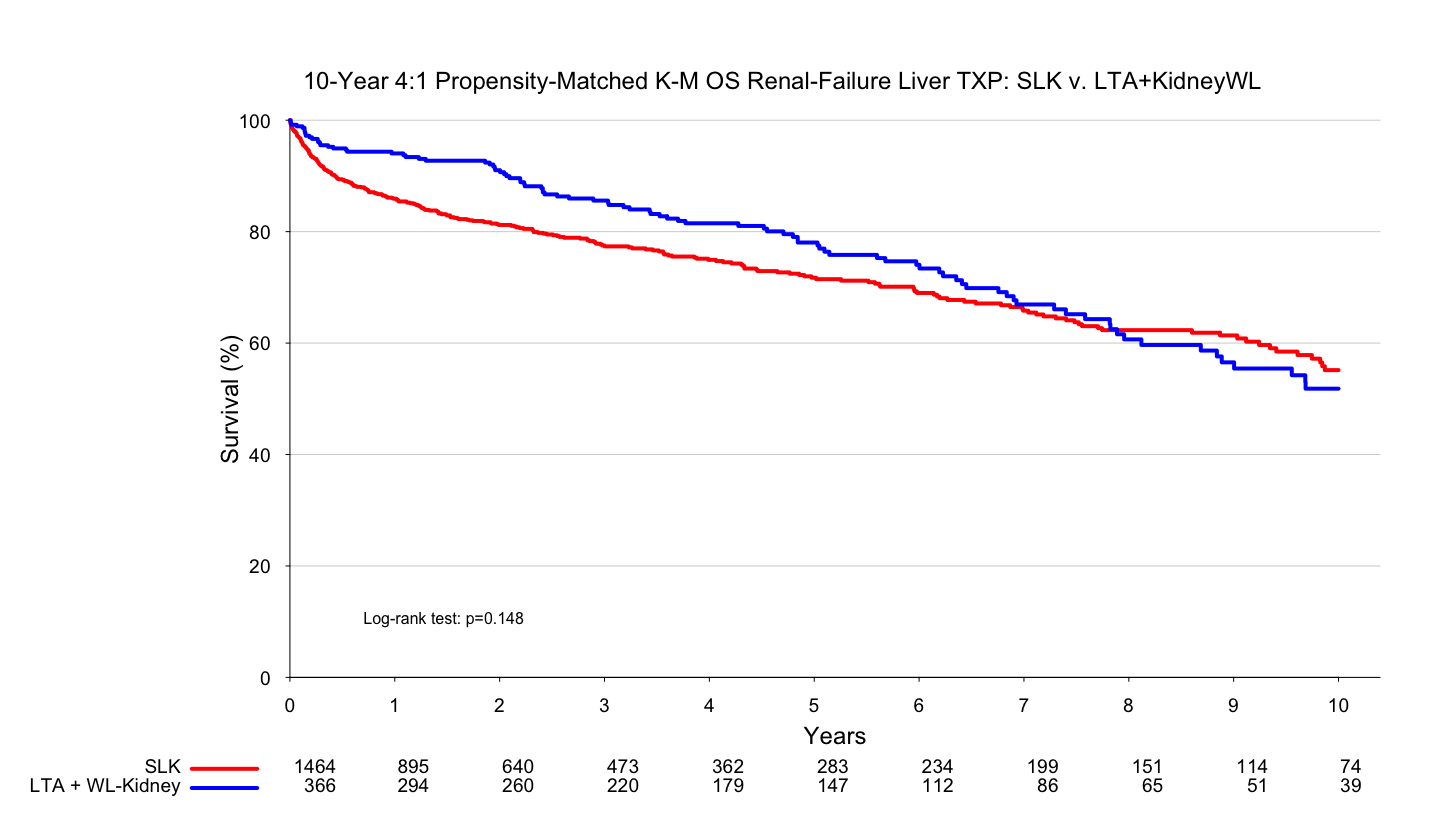Sequential Liver-Kidney Transplantation Is Equivalent to Simultaneous Liver–Kidney Transplantation in Candidates Requiring Dialysis Pre-Transplant.
Surgery, Duke University Medical Center, Durham, NC
Meeting: 2017 American Transplant Congress
Abstract number: C175
Keywords: Allocation, Kidney/liver transplantation, Liver transplantation, Renal failure
Session Information
Session Name: Poster Session C: Organ Allocation, Meld Score, Organ Utilization, and Transplant Outcomes
Session Type: Poster Session
Date: Monday, May 1, 2017
Session Time: 6:00pm-7:00pm
 Presentation Time: 6:00pm-7:00pm
Presentation Time: 6:00pm-7:00pm
Location: Hall D1
Introduction: Liver transplant is the optimal therapy for patients with end-stage liver disease (ESLD). Appropriately-selected candidates with renal impairment benefit from transplantation of liver and renal grafts. In these candidates, the optimal transplant strategy is unclear. We tested the hypothesis that simultaneous liver-kidney transplant (SLK) confers superior survival to a liver-alone followed by kidney waitlist transplant strategy (LTA-WL) in those with renal dysfunction.
Methods: UNOS/OPTN registry was queried for adult first-time liver recipients requiring dialysis pre-transplant following the introduction of MELD through 06-2016 (N=8690). Candidates were identified as those undergoing SLK (N=3328) and LTA+WL (N=366). Descriptive statistics were generated. Propensity score matching (4:1) was then used to match age and MELD. Cox proportional hazards models were developed and Kaplan-Meier analysis with log rank test were used to compare survival.
Results: 11.5% of recipients required dialysis prior to transplant. Those undergoing SLK were older (55 v 54yrs, p=0.034) and had higher serum creatinine (3.8 v 2.4, p<0.001). Those undergoing LTA+WL had higher INR (1.7 v 1.4), bilirubin (5.9 v 2.1) and MELD (37 v 30) (all p<0.001). In the LTA-WL group, 42% went on to undergo renal transplant. Mean time between transplants was 1131 days. Following matching, MELD was equivalent between SLK and LTA-WL (37 v 37, p=0.672). Serum creatinine was higher in SLK (3.4 v 3.0, p=0.048), while bilirubin was higher in LTA+WL (12.3 v 9.6, p<0.001). In the matched cohort, 1- and 10-year survival for SLK and LTA-WL were estimated at 85.9% and 55.1% for SLK, and 94.0% and 51.8% for LTA-WL, respectively (p=0.148).
Conclusion: Patients with ESLD and concomitant renal failure represent a significant fraction of liver transplant candidates. Of those requiring dialysis prior to transplant, those that undergo SLK have outcomes similar to those that undergo LTA-WL. Comparable outcomes between strategies have important implications for optimal allocation of organs to transplant candidates. 
CITATION INFORMATION: Mulvihill M, Yerokun B, Davis R, Anderson K, Hartwig M, Barbas A. Sequential Liver-Kidney Transplantation Is Equivalent to Simultaneous Liver–Kidney Transplantation in Candidates Requiring Dialysis Pre-Transplant. Am J Transplant. 2017;17 (suppl 3).
To cite this abstract in AMA style:
Mulvihill M, Yerokun B, Davis R, Anderson K, Hartwig M, Barbas A. Sequential Liver-Kidney Transplantation Is Equivalent to Simultaneous Liver–Kidney Transplantation in Candidates Requiring Dialysis Pre-Transplant. [abstract]. Am J Transplant. 2017; 17 (suppl 3). https://atcmeetingabstracts.com/abstract/sequential-liver-kidney-transplantation-is-equivalent-to-simultaneous-liver-kidney-transplantation-in-candidates-requiring-dialysis-pre-transplant/. Accessed December 12, 2025.« Back to 2017 American Transplant Congress
